MP Board Class 10th Science Solutions Chapter 9 Heredity and Evolution
MP Board Class 10th Science Chapter 9 Intext Questions
Class 10th Science Chapter 9 Intext Questions Page No.143
Question 1.
If a trait Aexists in 10% of a population of an asexually reproducing species and trait B exists in 60% of the same population, which trait is likely to have arisen earlier?
Answer:
Trait ‘B’ is likely to have arisen earlier. Because in asexually reproducing species, small differences are seen due to DNA replication.
Question 2.
How does the creation of variations in a species promote survival?
Answer:
Depending on the nature of variations, different individuals would have different kinds of advantages. Bacteria that can withstand heat will better in a heat wave, as selection of variants by environmental factors forms the basis for evolutionary process.
Class 10th Science Chapter 9 Intext Questions Page No. 147
Question 1.
How do Mendel’s experiments show that traits may be dominant or recessive?
Answer:
Mendel used a number 0 contrasting visible characters of garden peas-round/wrinkled seeds, tall/short plants, white/violet flowers and so on. He took pea plants with different characteristics a tall plant and a shot plant, produced progeny by crossing then, and calculated the percentages of tall or short progeny.
In the first place, there were no halfway characteristics in this first generation, or F1 progeny no medium-height plants. All plants were tall. This means that only one of the parental traits was seen, not some mixture of the two, so the next question was were the tall plants in the F1 generation exactly the same as the tall plants of the parent generation? Mendelian experiments test this by getting both the parental plans and these F1 tall plants to reproduce by self-pollination.
The progeny of the parental plants are of course, all tall. However the second generation, or F2 progeny of the F1 tall plants are not all tall. Instead, one quarter of them are short. This indicates that both the tallness and shortness traits were inherited in the F1 plants, but only the tallness trait was expressed. This led Mendel to propose that two copies of factor (now called genes) controlling traits are present in sexually reproducing organism. These two may be identified or may be different, depending on the percentage. A pattern of inheritance can be worked out with this assumption as shown in figure.
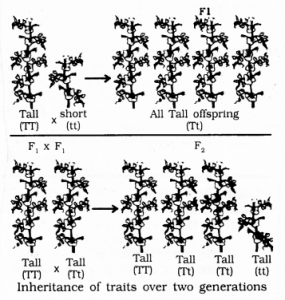
In this explanation, both TT and Tt are tall plants, while only it is a short plant. Traits like T are called dominant traits, while those that behave like ‘t’ are called recessive traits.
Question 2.
How do Mendel’s experiments show that traits are inherited independently?
Answer:
Mendel crossed
- pure breeding tall plants having round seeds and
- pure breeding short plants having wrinkled seeds.
The plants of F1 generation were all tall with round seeds indicating that the traits of tallness and round seeds were dominant.
While self breeding, of F1 yielded plants with characters of 9 tall round seeded, 3 tall wrinkled seeded, 3 short round seeded and one short wrinkled seeded. Tall wrinkled and short round seeded plants are new combinations which can develop only when the traits are inherited independently.
Question 3.
A man with blood group A marries a woman with blood group C and their daughter has blood group O. Is this information enougl to tell you which of the traits – blood group A or O – is dominant? Why or why not?
Answer:
From this information, it is not possible to tell which of the traits-blood group A or O is dominant. AA group becomes AO. So this information is complete.
Question 4.
How is the sex of the child determined in human beings?
Answer:
Pair of sex chromosomes determines the particular sex of a child. In human, the males have one X and one Y chromosome and the females have two X chromosomes therefore, the females are XX and the males are XY. The gametes receive half of the chromosomes. The child gametes have 22 autosomes and either X or Y sex chromosome in males while X in females.
Type of male gametes: 22 + X Or 22 + Y.
Type of female gamete: 22 + X.
This is the basis of sex determination in human beings.
![]()
Class 10th Science Chapter 9 Intext questions Page No. 150
Question 1.
What are the different ways in which individuals with a particular trait may increase in a population?
Answer:
A big reason could be accurate copying of DNA and limited variations. Variation causes in generation of new traits and non preserving of existing parental traits. Individuals with a particular trait may also increase due to natural selection that is trait offers some survival advantage. Genetic drift which is caused by genes governing that trait become common in a population.
Question 2.
Why are traits acquired during the life-time of an individual not inherited?
Answer:
Variation is not hereditary from generation to generation. In case of Asexual reproduction DNA will not transfer to germ cells. So experiences of an individual during its lifetime cannot be passed on to its progeny and cannot direct evolution.
Question 3.
Why are the small numbers of survivingjigers a cause of worry from the point of view of genetics?
Answer:
Tigers are adopted to their environment as per genes. If tigers number is decreasing number of genes also decrease. So its generation is becoming less.
Class 10th Science Chapter 9 Intext Questions Page No. 151
Question 1.
What factors could lead to the rise of a new species?
Answer:
Variations, non copying of DNA, natural selection, genetic drift and acquisition of traits during the life time of an individual can give rise to new species.
Question 2.
Will geographical isolation be a major factor in the speciation of a self-pollinating plant species? Why or why not?
Answer:
Geographical isolation will not a major factor in the speciation of a self pollinating plant species, because self pollination is taking place in one plant. In cross pollination it is a major factor.
Question 3.
Will geographical isolation be a major factor in the speciation of an organism that reproduces asexually? Why or why not?
Answer:
Geographical isolation will not be a major factor in the speciation of an organism that reproduces asexually because it is a major factor in organisms that reproduces sexually.
Class 10th Science Chapter 9 Intext Questions Page No. 156
Question 1.
Give an example of characteristics being used to determine how close two species are in evolutionary terms.
Answer:
The characteristics in different organisms would be similar because they are inherited from a common ancestor. As an example, consider the fact that mammals have four limbs, as do birds, reptiles and amphibians. The basic structure of the limbs is similar through it has been modified to perform different functions in various vertebrates. Such a homologous characteristic helps to identify an evolutionary relationship between apparently different species.
Question 2.
Can the wing of a butterfly and the wing of a bat be considered homologous organs? Why or why not?
Answer:
The wing of a butterfly and the wing of a bat be is not considered homologous organs because the designs of the two wings, their structure and components are very different.
Question 3.
What are fossils? What do they tell us about the process of evolution?
Answer:
Fossils are the remains of organisms that once existed on earth.
We can gather information about the development of the structures from simple structured to complex structured organisms. They tell us about the phases of evolutions through which they must have undergone in order to sustain themselves in the competitive environment.
Class 10th Science Chapter 9 Intext Questions Page No. 158
Question 1.
Why are human beings who look so different from each other in terms of size, colour and looks said to belong to the same species?
Ans.
A species is a group of organisms that are capable of interbreeding to produce a fertile offspring. Skin colour, looks and size are all variety of features present in human beings. These features are genetic but also environmentally controlled. Various human races are formed based on these features. All human races have more than enough similarities to be classified as same species. Therefore, all human beings are a single species as humans of different colour, size and looks are capable of reproduction and can produce a fertile off spring.
Question 2.
In evolutionary terms, can we say which among bacteria, spiders, fish and chimpanzees have a ‘better’ body design? Why or why not?
Answer:
Bacteria is a better body design, because even though it a simple organism, it can survive in hot springs, at the bottom of sea and even in coldest ice covered place such as Antarctica.
![]()
MP Board Class 10th Science Chapter 9 NCERT Textbook Exercises
Question 1.
A Mendelian experiment consisted of breeding tall pea plants bearing violet flowers with short pea plants bearing white flowers. The progeny all bore violet flowers, but almost half of them were short. This suggests that the genetic make-up of the tall parent can be depicted as:
(a) TTWW
(b) TTww
(c) TtWW
(d) TtWw
Answer:
(c) TtWW. Genetic make up of tall plant.
Question 2.
An example of homologous organs is:
(a) our arm and a dog’s fore-leg.
(b) our teeth and an elephant’s tusks.
(c) potato and runners of grass.
(d) all of the above.
Answer:
(d) Both organs in all option have same basic structural design but have different functions and appearance.
Question 3.
In evolutionary terms, we have more in common with:
(a) a Chinese school-boy
(b) a chimpanzee
(c) a spider
(d) a bacterium
Answer:
(a) a Chinese school-boy.
Question 4.
A study found that children with light-coloured eyes are likely to have parents with light-coloured eyes. On this basis, can we say anything about whether the light eye colour trait is dominant or recessive? Why or why not?
Answer:
No, we cannot say anything about whether the light eye colour trait is dominant or recessive. As this information is not sufficient. For considering a trait as dominant or recessive, we need data of at least last three generations.
Question 5.
How are the areas of study – evolution and classification – interlinked?
Answer:
An example will help with this A brother and a sister are closely related. They have common ancestors in the first generation before them, namely their parents. A girl and her first cousin are also related, but less than the girl and her brother. This is because cousins have common ancestors, their grandparents, in the second generation before them, not in the first one. We can now appreciate that classification of species is in fact a reflection of their evolutionary relationship.
Question 6.
Explain the terms analogous and homologous organs with examples.
Answer:
Consider the fact that mammals have four limbs, as do birds, reptiles and amphibians. The basic structure of the limbs is similar though it has been modified to perform different functions in various vertebrates. This is an example of homologous characteristic.
We find that the wings of bats are skin folds stretched mainly between elongated fingers. But the wings of birds are feathery covering all along the arm. The design of the two wings, their structure and components, are thus very different. They look similar because they have a common use for flying, but their origins are not common. This makes them analogous characteristics, rather than homologous characteristics.
Question 7.
Outline a project which aims to find the dominant coat colour in dogs.
Answer:
There are variety of genes that govern coat colour of a dog. At least eleven identified gene series (A, B, C, D, E, F, G, M, P, S, T) that influence coat colour in dog.
A dog inherits one gene from each of its parents. The dominant gene gets expressed in the phenotype. For example, in the B series, a dog can be genetically black or brown.
Let us assume that one parent is homozygous black (BB), while the other parent is homozygous brown (bb)
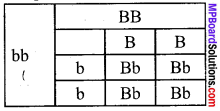
In this case, all the off springs will be heterozygous (Bb).
Since black (B) is dominant, all the offsprings will be black. However, they will have both B and b alleles.
If such heterozygous pups are crossed, they will produce 25% homozygous black (BB), 50% heterozygous black (Bb), and 25% homozygous brown (bb) offsprings.

Question 8.
Explain the importance of fossils in deciding evolutionary relationships.
Answer:
Analysis of the organ structure in fossils allows us to make estimates of how far back evolutionary relationships go. The wild cabbage plant is a good example. Humans have over more two thousand years, cultivated wild cabbage as a food plant, and generated different vegetables from it by selection. This is of course, artificial selection rather than natural selection. Kale, cauliflower. Broccoli, cabbage, Red cabbage and Kohl rabi all these have same ancestor.
Question 9.
What evidence do we have for the origin of life from inanimate matter?
Answer:
As we all know, that there occurs a time when our planet was lifeless, at that time intial matter to develop life was water, sand and some atmospheric gases as CO2, CH4 and nitrogen. The evidence for the origin of life from inanimate matter, was provided through an experiment, conducted in 1953, by Stanley L. Miller and Harold C. Urey. In experiment, they assembled an atmosphere containing molecules like ammonia, methane and hydrogen sulphide, but not oxygen.
This was similar to atmosphere that existed on early earth . This was maintained at a temperature just below 100°C and sparks were passed through the mixture of gases to simulate lightning. At the end of a week, 15% of the carbon from methane, had been converted to simple compounds of carbon including amino acids which make up protein molecules and support the life in basic form.
Question 10.
Explain how sexual reproduction gives rise to more viable variations than asexual reproduction. How does this affect the evolution of those organisms that reproduce sexually?
Answer:
Change in on-reproductive tissues cannot be passed on to the DNA of the germ cell. Therefore the experiences of an individual during its lifetime cannot be passed on to its progeny and cannot direct evolution.
Ex: If we breed a group of mice, all their progeny will have tails, as expected. Now, if the tails of these mice are removed by surgery in each generation, do these tailless mice have tailless progeny? The answer is no and it makes sense because removal of the tail cannot change the genes of the germ cells of the mice. Hence sexual reproduction gives rise to more viable variations than asexual reproduction.
Question 11.
How is the equal genetic contribution of male and female parents ensured in the progeny?
Answer:
Genetic inheritance begins at the time of conception, progeny inherited 23 chromosomes from female parent and 23 from male parent. Together it form 22 pairs of autosomal chromosomes and a pair of sex chromosomes (either XX in case of female, or XY in male). Homologous chromosomes have the same genes in the same positions, but may have different alleles (varieties) of those genes. An individual has two copies of alleles, and that can be homozygous (both copies the same) or heterozygous (the two copies are different) for given gene.
Hence, in human beings, equal genetic contribution of male and female parents is ensured in the progeny through inheritance of equal number of chromosomes from both parents. Females have a equal pair of two X sex chromosomes and males have a pair of one X and one Y sex chromosome. As fertilisation takes place, the male gamete (haploid) fuses with the female gamete (haploid) resulting in formation of the diploid zygote. The zygote in the progeny receive an equal contribution of genetic traits from the parental generations.
Question 12.
Only variations that confer an advantage to an individual organism will survive in a population. Do you agree with this statement? Why or why not?
Answer:
Only variations that confer an advantage to an individual organism will survive in a population we agree to this statement variation is convenient for survival. This provides diversity for organisms.
![]()
MP Board Class 10th Science Chapter 9 Additional Important Questions
MP Board Class 10th Science Chapter 9 Multiple Choice Questions
Question 1.
Fossil archaeopteryx exhibits connection between:
(a) Amphibian and fish
(b) Reptiles and fish
(c) Reptile and birds
(d) Birds and mammals
Answer:
(c) Reptile and birds
Question 2.
The sex of the human child depends on the sex chromosome present in the:
(a) Egg
(b) Spenn
(c) Both (a) and (b)
(d) None of these
Answer:
(b) Spenn
Question 3.
Genetic information is carried out by long chain of molecules made up of:
(a) Enzymes
(b) DNA
(c) Amino acids
(d) Proteins
Answer:
(b) DNA
Question 4.
Which one of the following represents a ratio of monohybrid cross?
(a) 9 : 7
(b) 3 : 1
(c) 1 : 1 : 1 : 1
(d) 9 : 3 : 3 : 1
Answer:
(b) 3 : 1
Question 5.
On which plant Mendel carried his experiments of inheritance?
(a) Cow pea
(b) Wild pea
(c) Garden pea
(d) Pigeon pea
Answer:
(c) Garden pea
Question 6.
A gamete certains which of the following?
(a) Both alleles of a gene
(b) Only one allele of a gene
(c) All alleles of a gene
(d) No allele of a gene
Answer:
(b) Only one allele of a gene
Question 7.
Chromosomes are made up of
(a) Proteins
(b) DNA
(c) RNA
(d) All of these.
Answer:
(d) All of these.
Question 8.
Pea plants were more suitable than cats for Mendel’s experiments because:
(a) Cats have many genetic traits
(b) No pedigree record of cats
(c) Pea plants can be self-pollinated or fertilised
(d) Pea plants favour cross pollination.
Answer:
(c) Pea plants can be self-pollinated or fertilised
Question 9.
In a cross Tt × Tt, the percentage of offsprings produced having same phenotype as the parents would be:
(a) 50%
(b) 100%
(c) 25%
(d) 0%
Answer:
(a) 50%
Question 10.
Who proposed the laws of heredity?
(a) Darwin
(b) Mendel
(c) Morgan
(d) Dalton
Answer:
(b) Mendel
![]()
MP Board Class 10th Science Chapter 9 Very Short Answer Type Questions
Question 1.
Define heredity.
Answer:
The process by which traits and characteristics are reliably inherited or passed from the parents to the offspring is called heredity.
Question 2.
What is a gene?
Answer:
Gene is a functional segment of DNA on a chromosome occupying specific position, which carries out a specific biological function.
Question 3.
Name the plant on which Mendel performed his experiments.
Answer:
Garden pea (Pisum sativum).
Question 4.
Define the term variation.
Answer:
Variation: There are differences found in structure, function, behaviour and genetic make up of different individuals of the same parentage, variety, race and species. These differences refer to variation.
Question 5.
Write the expanded form of DNA.
Answer:
Deoxyribonucleic acid (DNA).
Question 6.
Define genetics.
Answer:
The branch of biology which deals with heredity and variations, is known as genetics.
Question 7.
Define the term offspring.
Answer:
Offspring is an individual formed as a result of sexual reproduction involving the formation and fusion of two gametes. The genotype of an offspring is different from either of the parents due to shuffling of chromosomes and their genes.
Question 8.
What are reciprocal crosses?
Answer:
They are two types of crosses involving two groups of individuals where the male of one group is crossed with the female of the other and vice versa.
Question 9.
Where are the genes located? What is the chemical nature of gene?
Answer:
Genes are located at a specific position on a chromosome. Chemical Nature of Gene: Chemically, gene is a segment of deoxyribonucleic acid (DNA) consisting of specific sequence of the nucleotides. The sequence of the constituent nucleotides determines the functional property of a gene.
![]()
MP Board Class 10th Science Chapter 9 Short Answer Type Questions
Question 1.
Define genetics. What is the contribution of Mendel in this branch of Biology?
Answer:
Genetics is the branch of science of heredity and variations which deals with the study of the transmission of traits from parents to the offsprings and the occurrence of differences among the individuals.
Contribution of Mendel: Mendel did his experiments on garden pea (Pisum sativum) and discovered the scientific principles, which govern patterns of inheritance i.e., the principle of inheritance. He explained that contrasting characters are controlled by units which he called ‘Factors Today, these factors are called genes.
Question 2.
Differentiate between inherited and acquired traits.
Answer:
Inherited traits:
- The traits which are inherited from the parents (Father and Mother) to the offsprings (progeny) are called inherited traits.
- These traits are due to genetic make up of the progeny.
Acquired characters
- These traits cannot be passed on to their future generations.
- These traits develop in response to the environment.
Question 3.
What are Mendel’s laws of inheritance?
Answer:
Law of dominance: When two homozygous individuals with one or more sets of contrasting characters are crossed the characters that appear in the F, hybrids are dominant characters.
Law of segregation: Contrasting characters brought together in hybrid remain together without being contaminated and when gametes are formed from the hybrid, the two separate out from each other and only one enters each gamete.
Law of independent assortment: In inheritance of more than one pair of contrasting characters simultaneously, the factors for each pair of characters assort independently of other pair’s.
Question 4.
How did life originate on earth?
Answer:
Life originated on earth from inorganic elements and compounds under extreme atmospheric conditions (such as very high temperature, electric discharges, reducing atmosphere etc.) by formation of complex organic compounds such as amino acids.
Question 5.
Why did Mendel choose garden pea for his experiments?
Answer:
Due to the following reasons, Mendel selected garden pea for his experiment:
- Garden pea flowers are normally self-pollinated but can be easily cross-pollinated.
- Many varieties with distinguished contrasting characters e.g., smooth seed coat, wrinkled seed coat are available.
- A large number of progeny can be produced in a short duration.
- Its flowers can be easily handled for experimentation.
Question 6.
What are the factors which help in speciation?
- Genetic drift: Due to genetic drift, there will be accumulation of # different changes in each sub-populations. The levels of gene flow ’ between them will decrease if they are further isolated, it will be more on a small sub-population.
- Over generations, genetic drift will accumulate, causing different changes in the populations.
- Natural selection may also operate differently in the different geographical location.
- Together, genetic and natural selection will make the population more and more different from each other. As a result, members will be incapable of reproducing with each other. Changes may be due to change in DNA or number of chromosomes.
Question 7.
Does geographical isolation of individuals of a species lead to formation of a new species? Provide a suitable explanation.
Answer:
Yes, geographical isolation of sub-populations of a population of a species leads to genetic drift. This may impose limitations to.sexual reproduction of the separated population. Slowly, the separated individuals will reproduce among themselves and generate new variations. Continuous accumulation of those variations through a few generations may ultimately lead to the formation of a new species.
Question 8.
What tools have been used to study human evolution?
Answer:
The tools used for tracing evolutionary line are:
- Excavating time – dating and study of fossils.
- Determining DNA sequences.
![]()
MP Board Class 10th Science Chapter 9 Long Answer Type Questions
Question 1.
A husband have 46 chromosomes, his wife has 46 chromosomes. Then, why don’t their offspring have 46 pairs of chromosomes, which is obtained by the fusion of male and female gametes? Support your answer with a neat illustration.
Answer:
At the stage of gamete formation, meiosis division (reduction division) occurs. As a result, each gamete receives half number of chromosomes of the parent. So, when male gamete (sperm) fuses with egg, original number of chromosomes of the parent is received by the zygote.
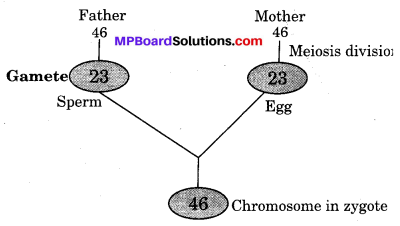
Fertilisation
Question 2.
Name the characters studied by Mendel in garden pea.
Answer:
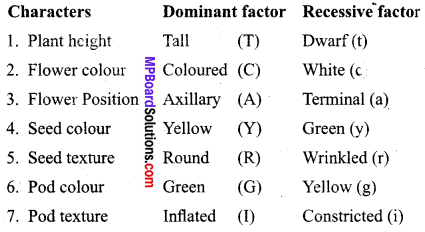
Question 3.
Explain the terms:
Monohybrid cross, dihybrid cross, monohybrid ratio and dihybrid ratio.
Answer:
Monohybrid cross: Monohybrid cross is that cross which is made to study the inheritance of a single pair of genes or factors of a character.
Dihybrid cross: It is a cross which is made to study the inheritance of two pairs of genes or two characters.
Monohybrid ratio: It is the ratio which is obtained in the F2 generation when a monohybrid cross is made. It is usually 3 : 1 (Phenotypic ratio) or 1 : 2 : 1 (genotypic ratio).
Dihybrid ratio: It is the ratio, which is obtained in the F2 generation when a dihybrid cross is studied. It is usually 9 : 3 : 3 : 1 (phenotypic ratio).
Question 4.
Describe any three methods of tracing evolutionary relationships among organisms.
Answer:
The following methods help us in tracing evolutionary relationships:
(i) Study of homologous organs: Organs which have similar structure and origin are called homologous organs. For example: limbs of birds, frog, human may look different but they have similar structure and origin. Such homologous organs help to identify an evolutionary relationship between apparently diffejent species.
(ii) Study of analogous organs: Analogous organs are similar in function but differ in structure and origin. For example’. forelimbs of birds and bats are used for flying but their origins and components are not common. Thus, study of analogous organs reveals difference in their ancestry and their evolutionary relationship.
(iii) Study of fossils: All impressions, casting of body or hard remains of ancient life in the sedimentary rocks are called fossils. Study of fossils helps in finding out:
(a) Interrelationship of ancient life.
(b) Correlation of forms of life existing today and their line of evolution from ancient life.
Question 5.
A tall pea plant bearing violet flowers is crossed with short pea plant bearing white flowers. Work out the F1 and F2 generations. Give F2 ratio.
Answer:
Parents: Tall pea plant with violet flower × Short pea plant with white flower
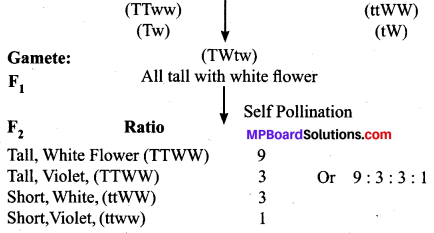
Question 6.
Given below is the experiment carried out by Mendel to study inheritance of two traits in garden pea:
(а) What do A, B, C, D, E, F and G represent in these boxes?
(b) State the objective for which Mendel performed this experiment.
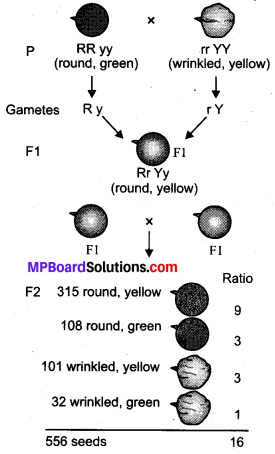
Independent inheritance of two separate traits, shape, and colour of seeds.
Answer:
(a) A = gamete (Ry) of round green plant.
B = gamete (rY) of wrinkled yellow plant.
C = (RrYy).
D = 9, E = 3, F = 3, G = 1.
(b) To show independent inheritance of traits or to prove law of independent assortment.
![]()
MP Board Class 10th Science Chapter 9 NCERT Textbook Activities
Class 10 Science Activity 9.1 Page No. 143
Observe the ears of all the students in the class. Prepare a list of students having free or attached earlobes and calculate the percentage of students having each (Fig. 9.1). Find out about the earlobes of the parents of each student in the class. Correlate the earlobe type of each student with that of their parents. Based on this evidence, suggest a possible rule for the inheritance of earlobe types.
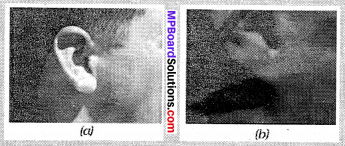
(a) Free and (b) attached earlobes. The lowest part of the ear, called the earlobe, is closely attached to the side of the head in some of us, and not in others. Free and attached earlobes are two variants found in human populations.
Observations:
- Earlobes can be free or attached. The genes for earlobe inheritance consists of two alleles. Both the alleles for attached and free earlobes can be present in a single human being, the one which is dominant shows and the recessive one do not express itself,
Class 10 Science Activity 9.2 Page No. 144
- In Fig. 9.2, what experiment would we do to confirm that the F2 generation did in fact have a 1 : 2 : 1 ratio of TT, Tt and tt trait combinations?
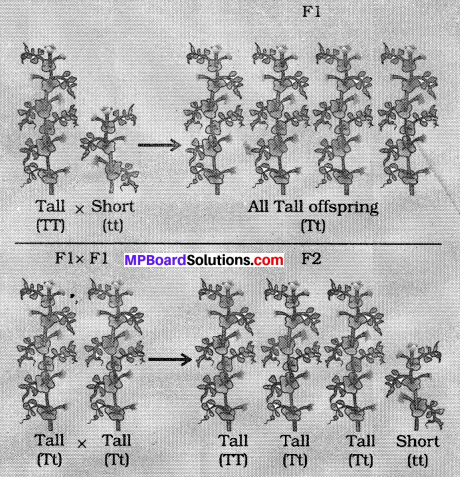
Inheritance of traits over two generations.
Observations:
The cross fertilisation of pea plants showing different traits can be done at F2 stage and the number of plants for particular trait (height here) can be studied and used to confirm 1 : 2 : 1 ratio of TT, Tt and it